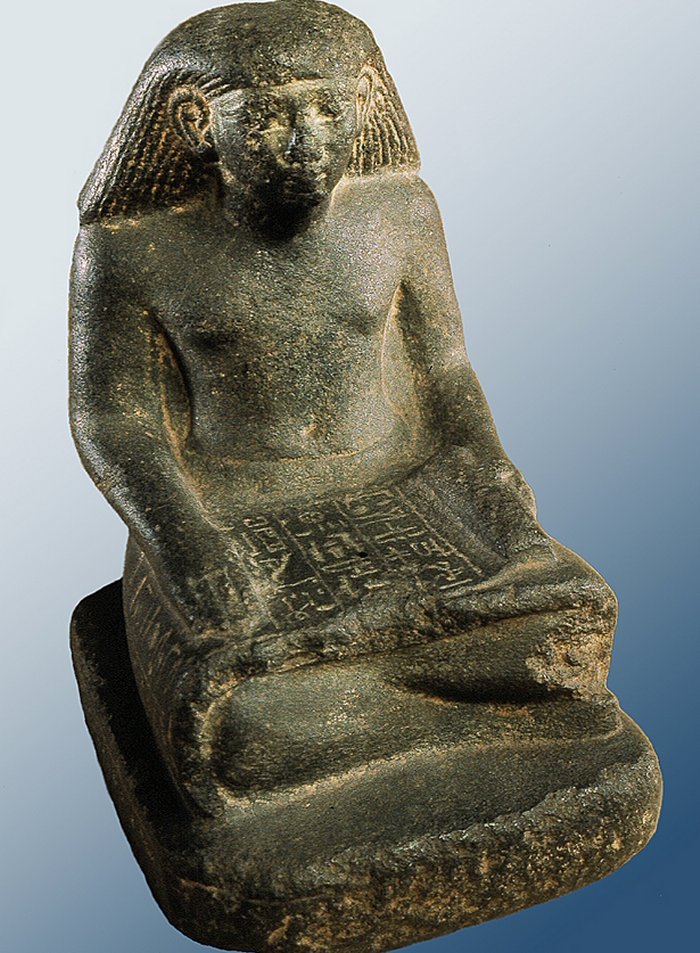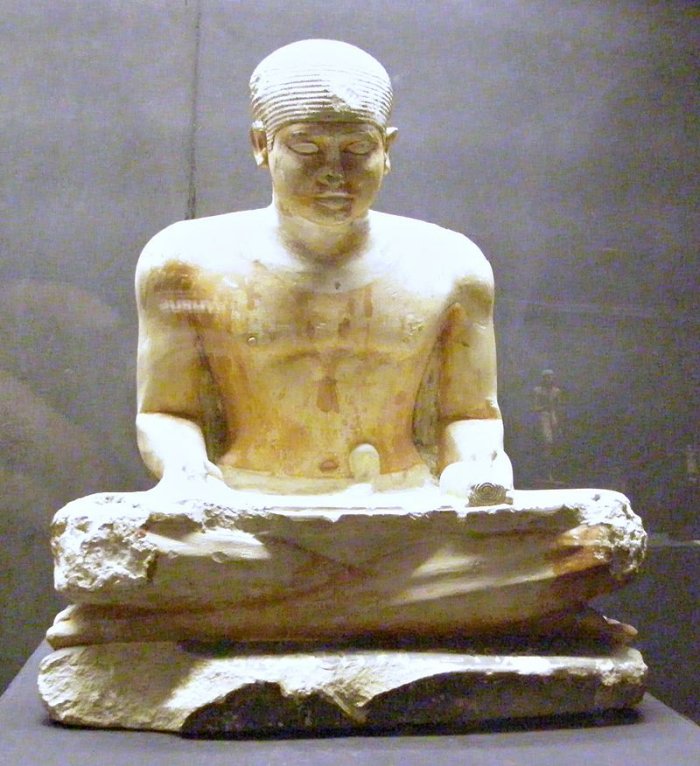Scribes: One Of The Noblest And Highly Recommended Professions In Ancient Egypt
A. Sutherland - AncientPages.com - Ancient Egypt did not have a public school system, so the average Egyptian could neither read nor write. It is estimated that less than one percent of Egyptians—at least during the Old Kingdom—were literate.
This early New Kingdom statue commemorates the scribe Minnakht ("Strength of Min") and demonstrates how ancient scribes read papyri – in a seated position on the floor with the text on their lap. Image credit: Walters Art Museum - Public Domain
Therefore, scribes were widely needed in the country. They represented the largest group of workers (after farmers), including thousands of officials, individuals hired to handle various accounts, official correspondence for large estates, and many freelancers.
Successful scribes never had to do manual labor as others, and society respected them widely.
Sources about ancient Egyptian scribes are known not only from tombs and depictions but also papyri, various seals, and graffiti.
The ancient site in Gebelein, known for its cemetery, has archeological finds stretching from the Predynastic Period to the Middle Kingdom, including a beautiful example of a scribe's wooden box containing lumps of black and red ink, papyri, reeds, and a mortar (dated to the fourth dynasty).
Much of what we know today about ancient Egypt comes from the country's scribes, some of the most valuable professionals who were educated in writing. This writing included hieroglyphics, hieratic scripts, and the demotic script (the first millennium BC), mainly used as shorthand for commerce and arithmetic.
Thoth was the god credited with the invention of writing by the ancient Egyptians. He was the scribe of the gods who kept knowledge of scientific and moral laws. Ancient Egyptian scribes and officials left for us, ordinary people, excellent knowledge about the country's political, administrative, and economic activities due to the records, books, and inscriptions.
Thanks to the scribes, various documents mentioned all of Egypt's social classes and representatives of other nationalities.
Not Everyone Could Become A Scribe
A particular school was needed for scribes to become scribes. You would learn how to read and write hieroglyphics and hieratic scripts at this school. Usually, according to family tradition, the children of scribes became scribes. They were brought up in the same scribal tradition, sent to school, and inherited their fathers' positions after entering the civil service.
Statue of a scribe of the 5th dynasty, Museum at the necropolis of Saqqara; Catalogue Generale no. 63; statue belonged to a person called Ptahshepses and was found in Saqqara mastaba C10; numbering according to Maspero. Image credit: Harald Gaertner - CC BY-SA 3.0
Also, the sons of higher officials, sometimes even farmers' children, and the sons of artisans could attend local temples for instructions in letters.
Long Hard Work And Much Studies To Become A Scribe
It was hard work that usually took four to five years to go through scribe school, where all scholars were male. The scribe needed writing reed brushes dipped in red and black ink for daily work.
Most often, a professional scribe wrote on papyrus. However, the scribes could not do papyrus exercises during the studies because they were costly materials.
Early in the morning, each scribe came to his work with a small basket containing some bread and beer and returned home late afternoon. The students had to confront and learn many complicated scripts, including various signs. At first, they spent plenty of time acquainting themselves with hieroglyphic symbols by repeatedly copying them onto old pottery fragments, limestone flakes, or wood boards with replaceable surfaces until they remembered them perfectly.
Black ink was used for the body of a text, and red to mark chapter headings or significant phrases.
Later, after learning all the necessary basics, the student could begin copying onto papyrus, and yet, the scribe's other skills were needed though they were not easily mastered.
In the "Daily Life of the Ancient Egyptians" by Bob Brier and A. Hoyt Hobbs, we read:
"In addition to hieroglyphs - the picture symbols we most often associate with Egyptian writing - a more cursive form called hieratic was employed for handwriting, and a more abbreviated version called demotic was used for quick notes. When all three symbol systems had been committed to memory, a pupil who showed aptitude could move to advanced courses in mathematics and basic building practices, both of which were taught through practical examples rather than abstraction rules..."
Once again, it is important to stress that these studies were complex and, first of all, very boring for many children.
Scribes Had Many Privileges
Despite difficulties in their studies, however, many students successfully graduated and could become professional scribes with many privileges. As a scribe, a young man could enjoy opportunities for advancement. Specific orders of Egyptian priests required scribal skills, as did the quartermaster corps of the army and many government jobs.
Scribes were considered part of the royal court, were not enrolled for compulsory military service, and did not pay taxes. They were also free from the heavy manual labor and worked with painters and artisans who decorated reliefs and other building works with scenes, prominent figures, or hieroglyphic text.
Egyptian scribes were also extremely busy copying books of the dead for thousands of customers interested in immortality. Such copies did not always represent good quality; many scrolls (incredibly different spells) were beautifully decorated with colored paintings. Others were brief with no illustrations, but people paid for them, and generally, all the scribes' customers were satisfied.
Written by – A. Sutherland - AncientPages.com Senior Staff Writer
Updated on June 27, 2024
Copyright © AncientPages.com All rights reserved. This material may not be published, broadcast, rewritten or redistributed in whole or part without the express written permission of AncientPages.com
Expand for referencesReferences:
Rawlinson G. "Ancient Egypt"
Williams, R. J. Scribal Training in Ancient Egypt
More From Ancient Pages
-
 First Detailed Academic Study Of East African Maritime Traditions Shows Changes In Boatbuilding
Archaeology | May 11, 2022
First Detailed Academic Study Of East African Maritime Traditions Shows Changes In Boatbuilding
Archaeology | May 11, 2022 -
 Enigmatic Human Fossil Jawbone May Be Evidence Of An Early Homo Sapiens Presence In Europe
Evolution | May 2, 2023
Enigmatic Human Fossil Jawbone May Be Evidence Of An Early Homo Sapiens Presence In Europe
Evolution | May 2, 2023 -
 65,000-Year-Old ‘Stone Swiss Army Knives’ Show Early Humans Had Long-Distance Social Networks
Archaeology | Oct 22, 2022
65,000-Year-Old ‘Stone Swiss Army Knives’ Show Early Humans Had Long-Distance Social Networks
Archaeology | Oct 22, 2022 -
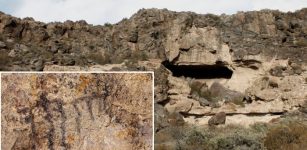 Puzzling Comb Drawing In Huenul Cave May Be The Oldest Rock Art In South America
Archaeology | Feb 15, 2024
Puzzling Comb Drawing In Huenul Cave May Be The Oldest Rock Art In South America
Archaeology | Feb 15, 2024 -
 Beautiful Legend Of Giant Olentzero Who Brings Christmas Presents To Basque Children
Christmas Traditions | Dec 19, 2024
Beautiful Legend Of Giant Olentzero Who Brings Christmas Presents To Basque Children
Christmas Traditions | Dec 19, 2024 -
 Sea Sequin ‘Bling’ Links Indonesian Islands’ Ancient Communities
Archaeology | Aug 16, 2023
Sea Sequin ‘Bling’ Links Indonesian Islands’ Ancient Communities
Archaeology | Aug 16, 2023 -
 The Hobbit – An Ancient Hominin Species May Still Be Living In The Forests Of Flores Island – Anthropologist Says
Archaeology | Apr 20, 2022
The Hobbit – An Ancient Hominin Species May Still Be Living In The Forests Of Flores Island – Anthropologist Says
Archaeology | Apr 20, 2022 -
 On This Day In History: Black Death Arrived In Britain – On June 24, 1348
News | Jun 24, 2016
On This Day In History: Black Death Arrived In Britain – On June 24, 1348
News | Jun 24, 2016 -
 Babylon Excavation Uncovers 478 Artifacts, Including Cuneiform Tablets and Seals
Archaeology | Oct 17, 2024
Babylon Excavation Uncovers 478 Artifacts, Including Cuneiform Tablets and Seals
Archaeology | Oct 17, 2024 -
 How Large Was The ‘Giant’ Dunkleosteus Terrelli – Prehistoric King Of The Oceans?
News | Apr 10, 2023
How Large Was The ‘Giant’ Dunkleosteus Terrelli – Prehistoric King Of The Oceans?
News | Apr 10, 2023 -
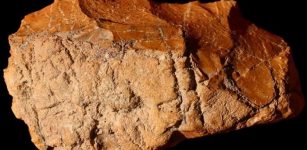 Traces Of Early Humans Discovered In Southern Iran
Archaeology | Sep 25, 2019
Traces Of Early Humans Discovered In Southern Iran
Archaeology | Sep 25, 2019 -
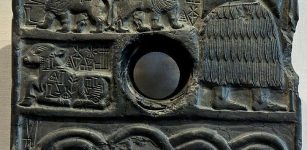 Babylonian Story Of Bird-God Anzu ‘The Wise One’ And His Underworld Realm
Featured Stories | Dec 10, 2016
Babylonian Story Of Bird-God Anzu ‘The Wise One’ And His Underworld Realm
Featured Stories | Dec 10, 2016 -
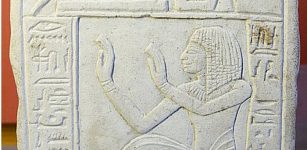 Meretseger: Theban Cobra Goddess Who Presided Over The Valley of The Kings
Egyptian Mythology | Jul 10, 2021
Meretseger: Theban Cobra Goddess Who Presided Over The Valley of The Kings
Egyptian Mythology | Jul 10, 2021 -
 Yuezhi Civilization: Ancient Nomadic People Who Once Ruled Bactria
Civilizations | Nov 29, 2018
Yuezhi Civilization: Ancient Nomadic People Who Once Ruled Bactria
Civilizations | Nov 29, 2018 -
 10 Enigmatic Ancient Underwater Ruins – Our Oceans Are Full Of Secrets
Featured Stories | Aug 13, 2019
10 Enigmatic Ancient Underwater Ruins – Our Oceans Are Full Of Secrets
Featured Stories | Aug 13, 2019 -
 When Science, Spirituality and Magic Meet – Re-Discovering Old Ancient Knowledge
Featured Stories | Feb 18, 2020
When Science, Spirituality and Magic Meet – Re-Discovering Old Ancient Knowledge
Featured Stories | Feb 18, 2020 -
 Kava – Astonishing Ancient Plant That Improves Emotional Intelligence Is Gaining Popularity In The Western World
Featured Stories | Mar 31, 2018
Kava – Astonishing Ancient Plant That Improves Emotional Intelligence Is Gaining Popularity In The Western World
Featured Stories | Mar 31, 2018 -
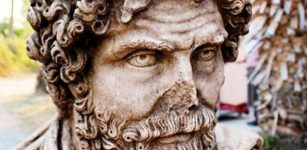 1,700-Year-Old Roman Bust Excavated In Ancient City Of Soli Pompeiopolis In Turkey
Archaeology | Jul 19, 2018
1,700-Year-Old Roman Bust Excavated In Ancient City Of Soli Pompeiopolis In Turkey
Archaeology | Jul 19, 2018 -
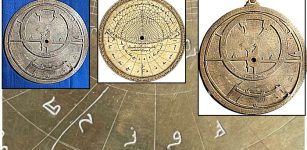 Rare Eleventh-Century Astrolabe Unearthed Recently Sheds Light On Islamic-Jewish Scientific Exchange
Scripts, Paintings & Inscriptions | Mar 4, 2024
Rare Eleventh-Century Astrolabe Unearthed Recently Sheds Light On Islamic-Jewish Scientific Exchange
Scripts, Paintings & Inscriptions | Mar 4, 2024 -
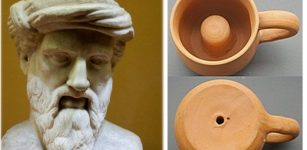 Pythagorean Cup Was A Practical Joke To Punish Greedy Drinkers And It Still Fools People
Ancient History Facts | Dec 18, 2020
Pythagorean Cup Was A Practical Joke To Punish Greedy Drinkers And It Still Fools People
Ancient History Facts | Dec 18, 2020

